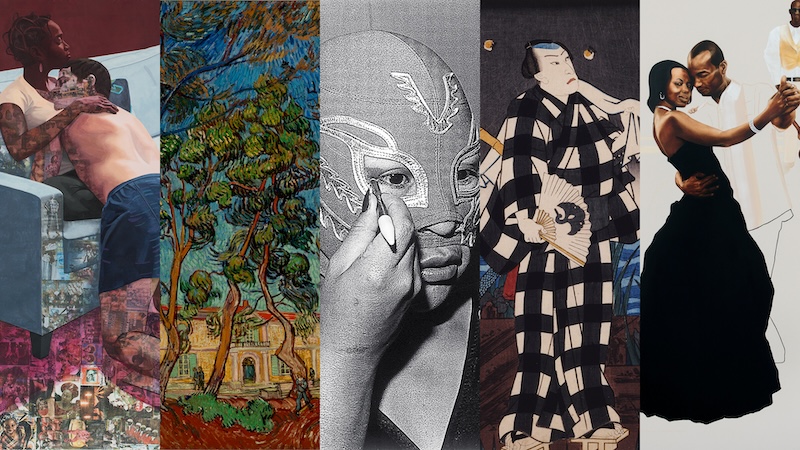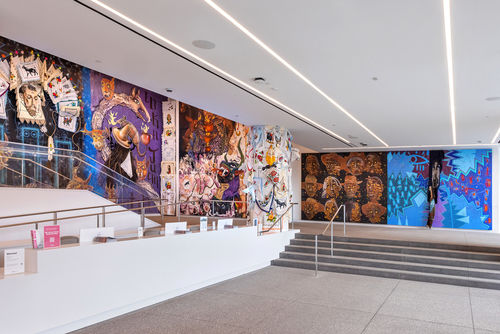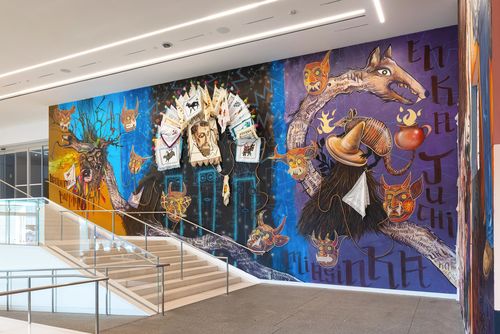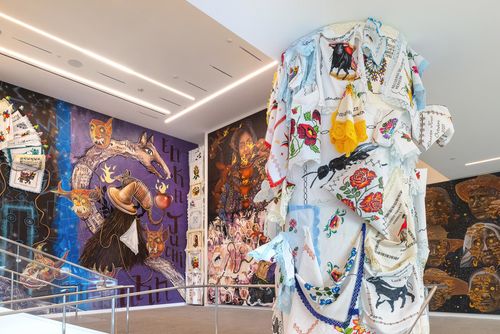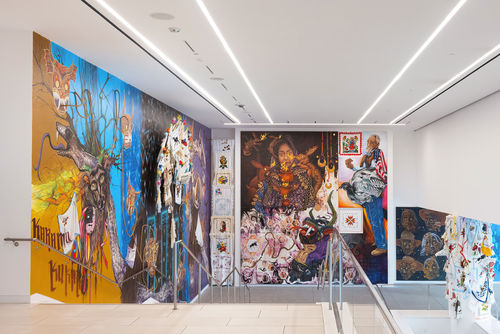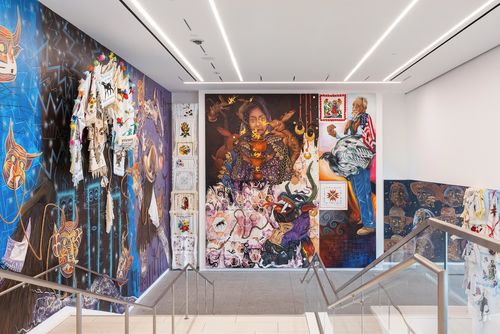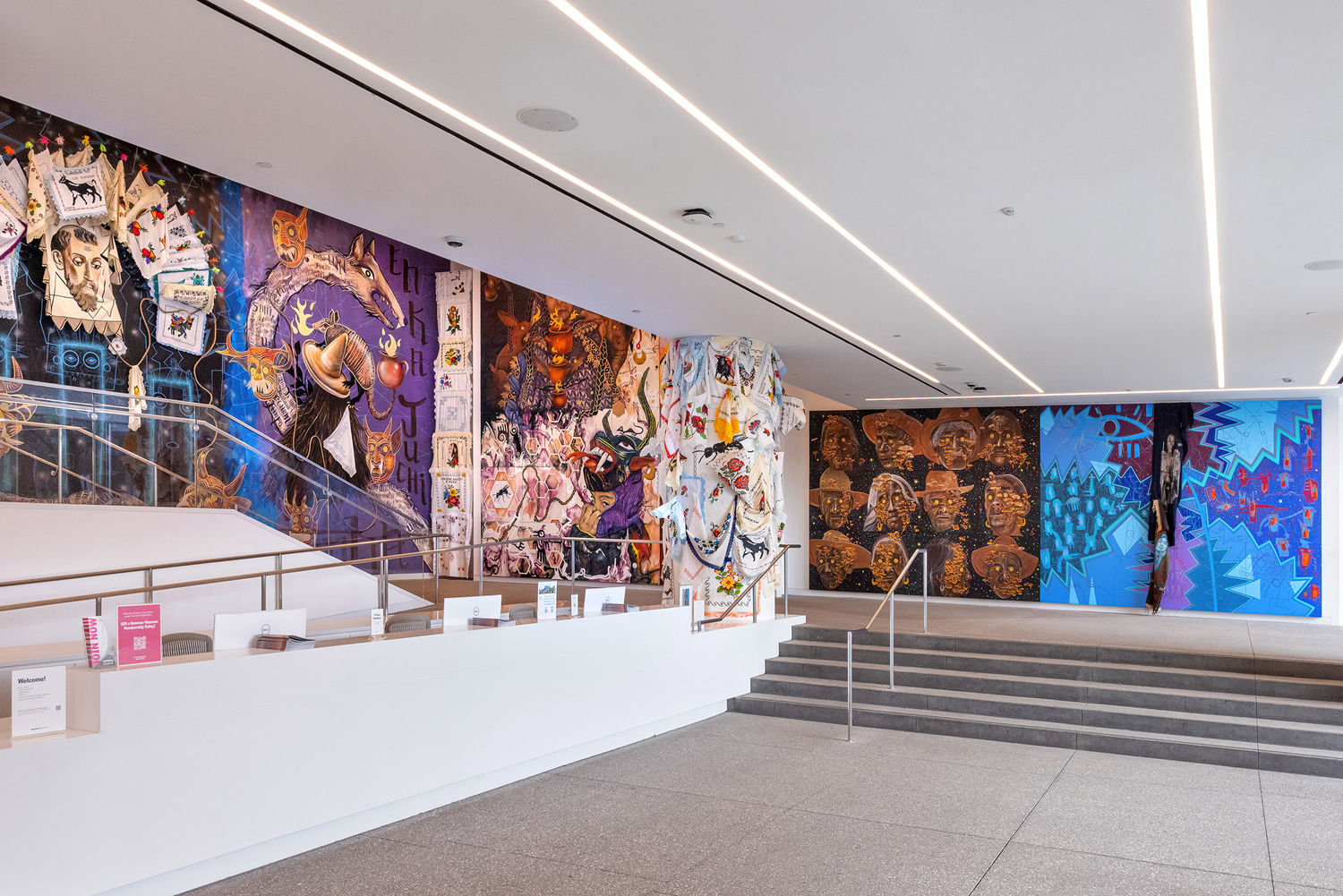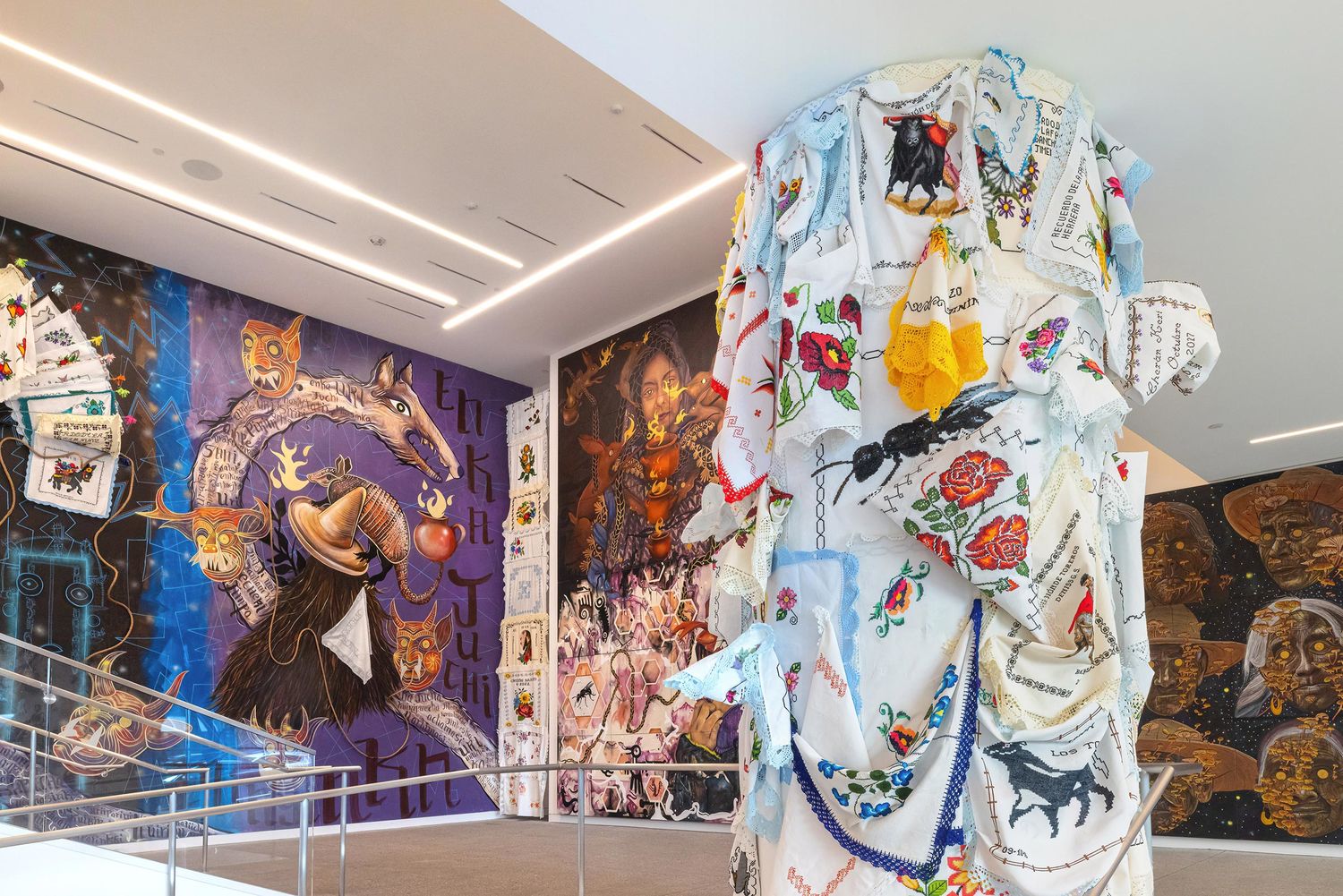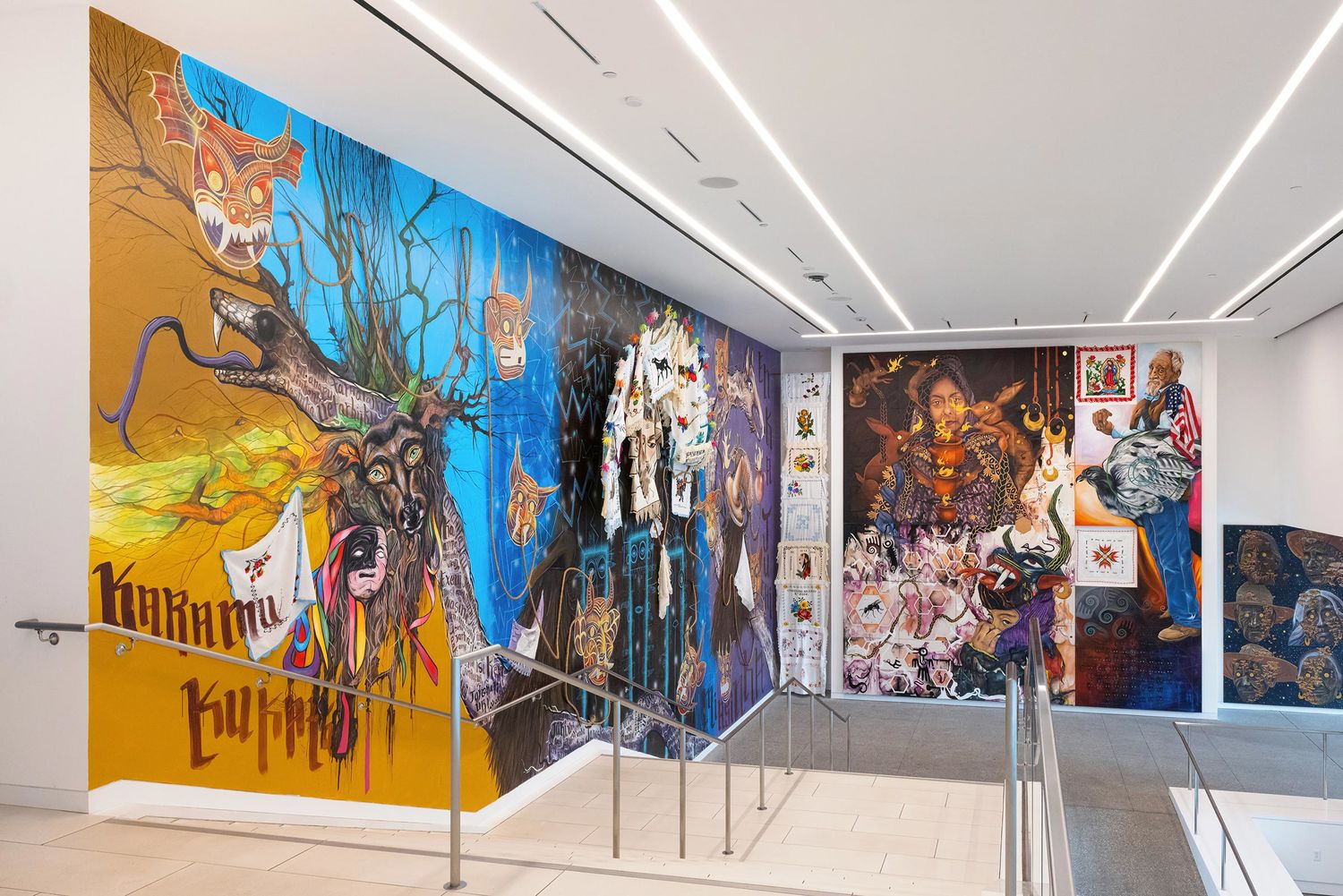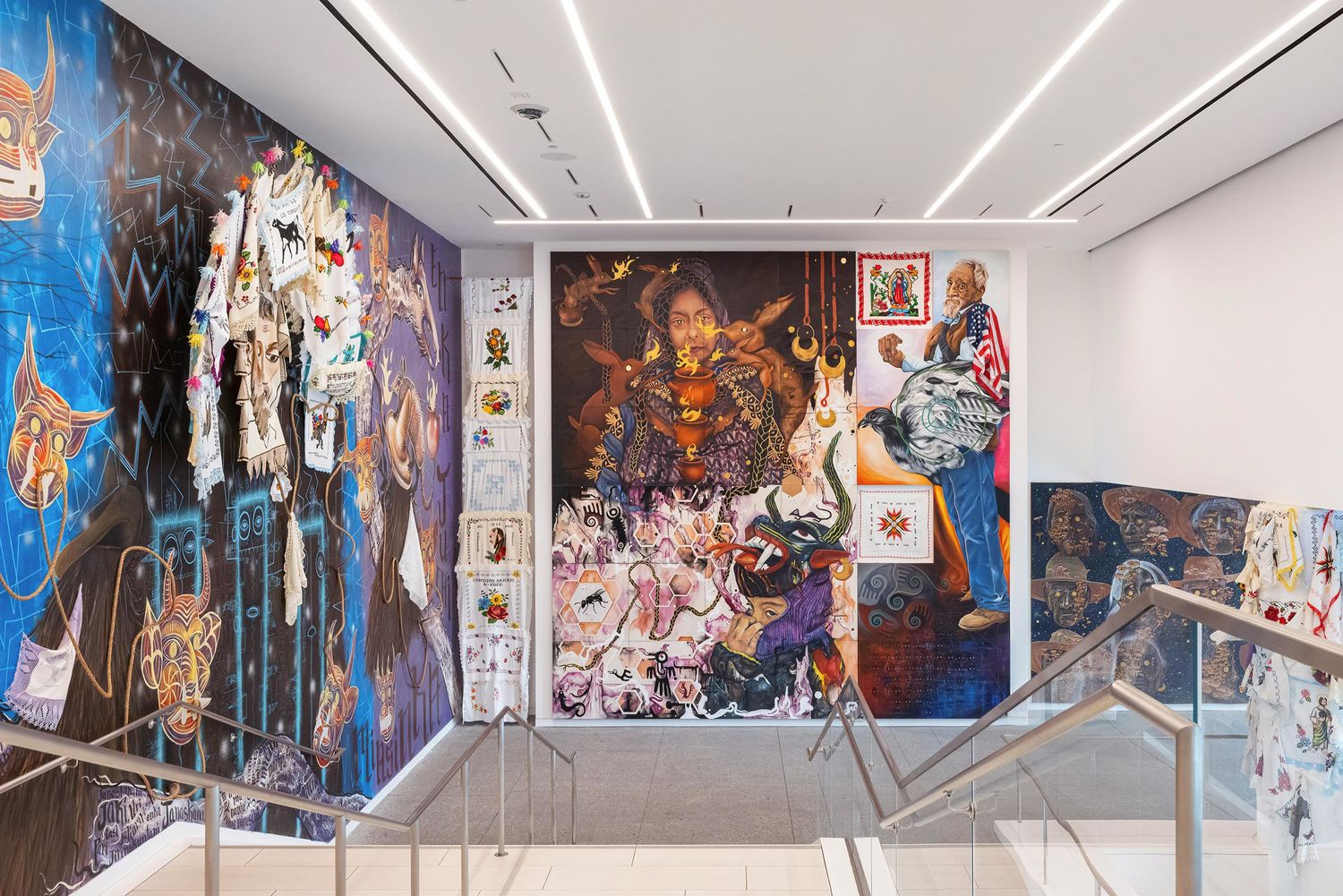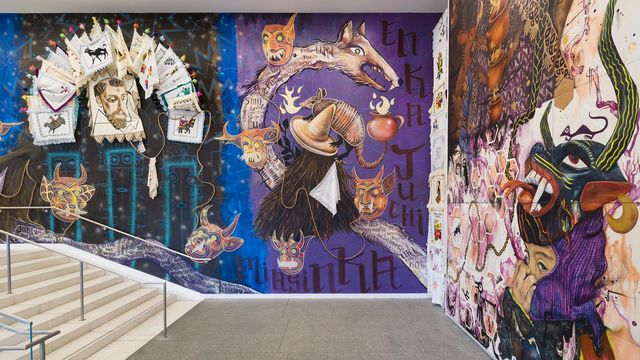
Hammer Projects: Colectivo Cherani
- – This is a past exhibition
Colectivo Cherani is a political and artistic initiative organized by an intergenerational group of artists: Betel Cucué, Giovanni Fabián Guerrero, Francisco Huaroco Rosas, Ariel Pañeda, and Alain Silva Guardian. Its name refers to the place where the collective was founded: Cherán, a town located in the state of Michoacán, Mexico. As part of a 2011 political uprising by the Purépecha community of Cherán, Colectivo Cherani has pioneered a cultural movement that seeks to recover and invigorate the plurality of cultural expressions of the Purépecha people. The collective’s output is characterized by the use of various artistic techniques, including painting, murals, graffiti, photography, installation, and hand-embellished objects, reflecting the customs and traditions of the community. Colectivo Cherani foregrounds the importance of communal justice, self-government, resistance, and the role of art and ancestral Indigenous traditions in transforming society.
Hammer Projects: Colectivo Cherani is organized by Pablo José Ramírez, curator, with Jessi DiTillio, curatorial assistant.
Essay
"Restarting Cherán" by Carlos Amorales
The story begins like this: Between the years 2008 and 2011, life became unbearable for the villagers of Cherán, a small Indigenous community in northwestern Michoacán, Mexico. In an effort to diversify their business, drug traffickers colluded with illegal loggers and razed entire pine forests in order to grow avocados, a lucrative agricultural commodity for export to the United States. This indiscriminate logging of pinewood and planting of avocado orchards by organized crime groups not only was a large-scale ecological disaster but also profoundly disrupted the culture and economy of the towns located on the Purépecha Plateau, especially those, such as Cherán, that make their living harvesting pinewood from the forests. The drug traffickers were able to change their business model with the support of corrupt regional authorities, who facilitated this rapacious enterprise. Their attack on the forest of Cherán required violence to thrive, and they subjugated the local population using an array of abhorrent tactics, including kidnapping, extortion, and targeted assassinations. Fear and paralysis plagued the inhabitants of Cherán until the early morning of April 15, 2011, when the entire town, led by the women, rose up against the criminals.
In his lecture “Stress and Freedom,” the German philosopher Peter Sloterdijk writes: “Political repression constitutes a stress system that proves successful as long as the oppressed tend more towards avoidance of stress . . . than rebellion and revolution. . . . Revolutions break out when collectives intuitively recalculate their stress balance at critical moments and reach the conclusion that existence in the attitude of submissive stress avoidance is ultimately more costly than the stress of rebellion.”1 When the Cherani women blocked the path of a convoy of logging trucks that was crossing the town en route to the highway to Capácuaro, one of the commercial waypoints of Michoacán, they forced a confrontation with the thugs. As Sloterdijk concludes, “Where such reckoning catches on, there will be no more tolerance of domination.” Following the Cherani women’s lead, the men of the town joined the fight to end the exploitation.
Since there were almost no weapons in the town at that time, they repurposed firecrackers normally used for parties as missiles, burning pickup trucks and disarming the criminals to take them as hostages. That confrontation changed the history of Cherán: the town established itself as an autonomous city, independent from the state and federal government. Since then, Cherán has become a town with no political parties, ruled by a traditional Indigenous system of government nourished by three cultures: those of Purépecha, Mexico, and North America.
Once the rebellion was over, Cherán returned to a state of calm. The new reality gave local artists the opportunity to dream and construct their role in an autonomous Indigenous society. It was in this sociopolitical context (in which the entire population was involved) that the elder painters Francisco Huaroco and Ariel Pañeda joined with the younger artists Bethel Cucué, Giovanni Fabián “Tóxico” Guerrero, and Alain Silva to form a collective through which to actively participate in the cultural life of the town. The new group, Colectivo Cherani, organized artistic events that have become important locally, such as the annual mural-painting festivals, which have brought artists from all over the country to paint the town's walls. This small collective, along with other affiliated artists, also manages Cherán’s Casa de Cultura, using it as a studio and exhibition space. The Cherán artists studied visual arts in Morelia, the capital of the state of Michoacan, which has opened their practices to global networks of contemporary artists and curators.
The artists of Colectivo Cherani not only work on personal pictorial, sculptural, and graphic work but also come together regularly to make collective projects that are directly related to the cultural dynamics of the town and the region. In 2014 Colectivo Cherani created Museo del Sitio de Cherán (Cherán site museum), which, in my view, is one of the most important collaborative art projects that has been made in Mexico. Museo del Sitio is a set of outdoor sculptures located in the forest on the outskirts of the town. The large-scale artworks were made by repurposing the remains of vehicles and objects used during the Cherán uprising of 2011. After the insurrection the trucks were left in a junkyard for some time until Huaroco and Pañeda had the idea of bringing them to the forest to make an installation that would commemorate the events that had transpired. Each artist in the collective intervened on one of the vehicles, and together they created something that is of profound importance for every community: a monument to their own history that allows people to remember and understand the importance of the events that make up a historical watershed. It is a poetic and artistic gesture that allows visitors to feel the strength of the people of Cherán. Museo del Sitio also allows us to clearly understand the importance that art and artists can have in society: In a given social context, the artist has the function of making it possible for the symbolic to manifest itself in public space.
Drawing from such a powerful myth of origin as the one narrated at the beginning of this text, the members of Colectivo Cherani combine group work with their own individual careers. Each artist works in his own studio mainly on figurative pictorial work in which images of Purépecha mythology are combined with political and historical themes. Colectivo Cherani works at a crossroads of many seemingly contradictory positions, allowing us to see in its practice the intersection of traditional and contemporary Purépecha culture, the meeting of individual and collaborative creative processes, and the relevance of regional specificities to the global contemporary art world.
Carlos Amorales is a multidisciplinary artist from Mexico City who explores themes of culture and history.
1. Peter Sloterdijk, Stress and Freedom, trans. Wieland Hoban (Polity, 2016), 24–25.
Hammer Projects are single-gallery exhibitions highlighting the work of contemporary artists from around the globe, often presenting new work at a pivotal moment of an artist’s development. Ongoing since 1999, Hammer Projects is a signature series within the Hammer’s exhibition program.
Hammer Projects is presented in memory of Tom Slaughter and with support from the Horace W. Goldsmith Foundation. Lead funding is provided by the Hammer Collective. Generous support is provided by Susan Bay Nimoy and Leonard Nimoy, with additional support from the Los Angeles County Board of Supervisors through the Department of Arts and Culture.


